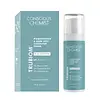What's inside
What's inside
 Key Ingredients
Key Ingredients

 Benefits
Benefits

 Concerns
Concerns

 Ingredients Side-by-side
Ingredients Side-by-side

Water
Skin ConditioningNiacinamide
SmoothingTranexamic Acid
AstringentKojic Acid
AntioxidantCetearyl Alcohol
EmollientDicetyl Phosphate
EmulsifyingCeteth-10 Phosphate
CleansingC12-15 Alkyl Benzoate
AntimicrobialAzelaic Acid
BufferingPolyglutamic Acid
Skin ConditioningBetaine
HumectantTrehalose
HumectantTrimethylolpropane Tricaprylate/Tricaprate
EmollientHydrolyzed Milk Protein
Skin ConditioningPhenylalanine
MaskingPantothenic Acid
Skin ConditioningAllantoin
Skin ConditioningOenothera Biennis Oil
EmollientSodium Lactate
BufferingMorus Alba Leaf Extract
Skin ConditioningHyaluronic Acid
HumectantStomach Extract
HumectantGlycyrrhiza Glabra Root Extract
BleachingPhenoxyethanol
PreservativeXanthan Gum
EmulsifyingBenzyl Alcohol
PerfumingGlyceryl Laurate
EmollientZea Mays Oil
EmulsifyingWater, Niacinamide, Tranexamic Acid, Kojic Acid, Cetearyl Alcohol, Dicetyl Phosphate, Ceteth-10 Phosphate, C12-15 Alkyl Benzoate, Azelaic Acid, Polyglutamic Acid, Betaine, Trehalose, Trimethylolpropane Tricaprylate/Tricaprate, Hydrolyzed Milk Protein, Phenylalanine, Pantothenic Acid, Allantoin, Oenothera Biennis Oil, Sodium Lactate, Morus Alba Leaf Extract, Hyaluronic Acid, Stomach Extract, Glycyrrhiza Glabra Root Extract, Phenoxyethanol, Xanthan Gum, Benzyl Alcohol, Glyceryl Laurate, Zea Mays Oil
Water
Skin ConditioningNiacinamide
SmoothingPropylene Glycol
HumectantTranexamic Acid
AstringentAlpha-Arbutin
AntioxidantPEG-40 Hydrogenated Castor Oil
EmulsifyingPhenoxyethanol
PreservativeAcrylates/C10-30 Alkyl Acrylate Crosspolymer
Emulsion StabilisingZinc PCA
HumectantOryza Sativa Seed Water
AntimicrobialSaccharomyces Ferment
Skin ConditioningLactobacillus Ferment
Skin ConditioningSea Water
HumectantGlycerin
HumectantHydrolyzed Quinoa
Skin ConditioningAllantoin
Skin ConditioningPanthenol
Skin ConditioningDisodium EDTA
Acetyl Hexapeptide-8
HumectantCopper Tripeptide-1
Skin ConditioningPalmitoyl Pentapeptide-4
Skin ConditioningTripeptide-1
Skin ConditioningHexapeptide-9
Skin ConditioningPalmitoyl Tripeptide-1
Skin ConditioningPolyglyceryl-10 Laurate
Skin ConditioningButylene Glycol
Humectant1,2-Hexanediol
Skin ConditioningHarungana Madagascariensis Extract
Skin ConditioningBrassica Oleracea Italica Seed Oil
EmollientWater, Niacinamide, Propylene Glycol, Tranexamic Acid, Alpha-Arbutin, PEG-40 Hydrogenated Castor Oil, Phenoxyethanol, Acrylates/C10-30 Alkyl Acrylate Crosspolymer, Zinc PCA, Oryza Sativa Seed Water, Saccharomyces Ferment, Lactobacillus Ferment, Sea Water, Glycerin, Hydrolyzed Quinoa, Allantoin, Panthenol, Disodium EDTA, Acetyl Hexapeptide-8, Copper Tripeptide-1, Palmitoyl Pentapeptide-4, Tripeptide-1, Hexapeptide-9, Palmitoyl Tripeptide-1, Polyglyceryl-10 Laurate, Butylene Glycol, 1,2-Hexanediol, Harungana Madagascariensis Extract, Brassica Oleracea Italica Seed Oil
 Reviews
Reviews

Ingredients Explained
These ingredients are found in both products.
Ingredients higher up in an ingredient list are typically present in a larger amount.
Allantoin is a soothing ingredient known for its protective and moisturizingg properties. Because of this, it is often added to products with strong active ingredients.
Studies show higher concentrations of this ingredient can promote wound healing.
Though it can be derived from the comfrey plant, allantoin is produced synthetically for cosmetic products to ensure purity.
Learn more about AllantoinNiacinamide is a multitasking form of vitamin B3 that strengthens the skin barrier, reduces pores and dark spots, regulates oil, and improves signs of aging.
And the best part? It's gentle and well-tolerated by most skin types, including sensitive and reactive skin.
You might have heard of "niacin flush", or the reddening of skin that causes itchiness. Niacinamide has not been found to cause this.
In very rare cases, some individuals may not be able to tolerate niacinamide at all or experience an allergic reaction to it.
If you are experiencing flaking, irritation, and dryness with this ingredient, be sure to double check all your products as this ingredient can be found in all categories of skincare.
When incorporating niacinamide into your routine, look out for concentration amounts. Typically, 5% niacinamide provides benefits such as fading dark spots. However, if you have sensitive skin, it is better to begin with a smaller concentration.
When you apply niacinamide to your skin, your body converts it into nicotinamide adenine dinucleotide (NAD). NAD is an essential coenzyme that is already found in your cells as "fuel" and powers countless biological processes.
In your skin, NAD helps repair cell damage, produce new healthy cells, support collagen production, strengthen the skin barrier, and fight environmental stressors (like UV and pollution).
Our natural NAD levels start to decline with age, leading to slower skin repair, visible aging, and a weaker skin barrier. By providing your skin niacinamide, you're recharging your skin's NAD levels. This leads to stronger, healthier, and younger looking skin.
Another name for vitamin B3 is nicotinamide. This vitamin is water-soluble and our bodies don't store it. We obtain Vitamin B3 from either food or skincare. Meat, fish, wheat, yeast, and leafy greens contain vitamin B3.
The type of niacinamide used in skincare is synthetically created.
Learn more about NiacinamidePhenoxyethanol is a preservative that has germicide, antimicrobial, and aromatic properties. Studies show that phenoxyethanol can prevent microbial growth. By itself, it has a scent that is similar to that of a rose.
It's often used in formulations along with Caprylyl Glycol to preserve the shelf life of products.
Tranexamic Acid is best used for treating hyperpigmentation, discoloration, and melasma. It can also help build a stronger skin barrier.
Once applied, Tranexamic Acid starts decreasing inflammation from UV exposure. Tranexamic Acid also prevents our skin cells from meeting the pigment production cells.
Its brightening property makes it great at reducing the appearance of acne scars and marks.
Fun fact: Tranexamic Acid is also a medication used to reduce heavy bleeding.
This acid is derived from lysine, an amino acid.
Learn more about Tranexamic AcidWater. It's the most common cosmetic ingredient of all. You'll usually see it at the top of ingredient lists, meaning that it makes up the largest part of the product.
So why is it so popular? Water most often acts as a solvent - this means that it helps dissolve other ingredients into the formulation.
You'll also recognize water as that liquid we all need to stay alive. If you see this, drink a glass of water. Stay hydrated!
Learn more about Water